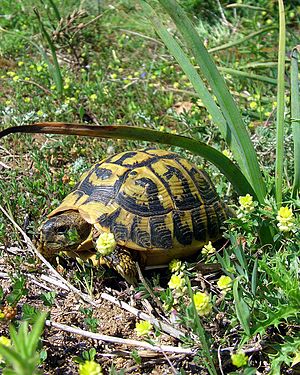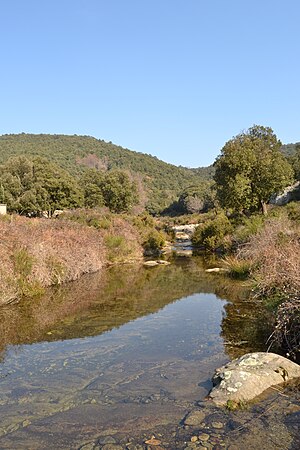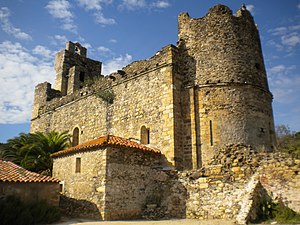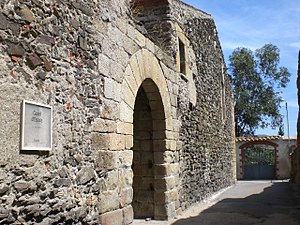Paratge Natural d'Interès Nacional de l'Albera
The Paratge Natural d'Interès Nacional de l'Albera is a Catalan natural park on the south side of the Serra de l'Albera , which was established in 1986. It covers an area of 42.07 square kilometers.
location

The nature park is located in the northeast of the Comarca Alt Empordà in the province of Girona on the south side of the Serra de l'Albera . It extends over areas of the municipalities of La Jonquera , Espolla and Rabós .
It is divided into two separate sectors: in the west the area around Requesens - Bausitges and in the east the area of Sant Quirze de Colera - Serra de Balmeta . Both areas are separated from each other by the Col de Banyuls . The eastern part surrounds the important Abbey of Sant Quirze, a true jewel of Catalan Romanesque .
The eponymous Serra de l'Albera forms the extreme east of the Pyrenees chain, which then plunges into the Mediterranean . It separates the plains of the Roussillon on the French side from those of the Alt Empordà in Catalonia. The Spanish-French border follows its ridge. The approximately 25 km long chain has the Puig Neulós as its highest peak , which reaches 1257 meters. Other important peaks in the Serra are the Puig dels Pastors with 1167 meters, the Puig dels Quatre Termes with 1156 meters and the Pic de Sallfor with 992 meters.
introduction
From a scenic and ecological point of view, the nature park forms a high-quality unit. It documents the transition from species characteristic of the mountains of the Pyrenees to typical Mediterranean forms. The rock world is dominated by metamorphic rocks from the Pyrenees, predominantly Variscan slates from the Cambrian / Ordovician .
history
The need to put the ecosystems of the Serra de l'Albera under protection had already been recognized in 1931 in a plan drawn up by the Generalitat de Catalunya for this purpose . It was not until 1986 that the Catalan parliament finally designated areas of the southern slope of the Serra de l'Albera in the north of Alt Empordà as Paratge natural d'interès nacional (Natural Park of National Interest). Act 3/86 of March 10, 1986 and the two decrees 123/87 of March 12, 1987 and 119/89 of April 17, 1989 are decisive for the nature park.
A total of 4,207 hectares are under protection, of which 969 hectares are nature reserves. The secluded reserve around Sant Quirze de Colera covers 742 hectares. Two nature reserves are designated within the nature park, the first on the upper reaches of the Orlina with an area of 395 hectares. It lies between the Coll des Emigrants and the Pic de Sallfor and protects the native beech and oak forests . The second, with an area of 580 hectares, is located between the valley of Sant Quirze and the upper reaches of the Valleta . The task is to protect its reptile fauna, especially the Greek tortoise . In 1987 the nature park was expanded by 680 hectares on its southwestern edge. The Réserve naturelle nationale de la forêt de la Massane was set up on the north side of the Serra de l'Albera in France between the Puig dels Quatre Termes and the Pic de Sallfor .
The Spanish Consejo del Patrimonio Histórico has proposed the Mediterranean side of the Pyrenees, which also includes the cultural and natural landscape of the Albères massif , as a candidate for UNESCO World Heritage .
Natural heritage
vegetation
The park section Requesens-Baussitges provides the most humid and highest-lying ecotopes and is almost 100% made up of bushes. Its vegetation is extremely varied and contains elements from both lower and higher levels of vegetation, with cork oaks , sweet chestnuts , oaks, red beeches, mixed shrubbery from hardwoods such as maple, elm, etc. up to alpine pastures on the mountain level. The surroundings of Requesens include the catchment area of the Anyet with excellent river vegetation consisting of ash , willow and black alder . The landscape around Baussitges includes the upper reaches of the Orlina, where the easternmost beech stands of the Iberian Peninsula can be found. The sector of Sant Quirze de Colera-Serra de la Balmeta already shows fully Mediterranean floral elements, which are characterized by their high fire hazard. The vegetation here is dominated by cork oaks, heather mats and maquis (matorral). The so-called Aspres de l'Albera are a transition area between the Serra proper and the Ampurdan plain. Their vegetation is dominated by a mosaic of drought-resistant species such as vines and olives, which have mixed between the natural vegetation of cork oaks and maquis plants.
Wildlife
The last populations of the Greek tortoise ( Testudo hermanni hermanni ) on the Iberian Peninsula can be found in the area of the nature park . It is also worth mentioning the pronounced diversity among the reptiles: frogs, snakes, lizards and salamanders.
More than 200 species of birds have been recorded. Among the fish, trout and barbel are generally to be mentioned in the mountain region. The biodiversity among mammals in the natural park is remarkable, 44 species have been counted - which corresponds to 75% of the total mammal population in Catalonia.
The Albera cattle is an autochthonous, semi-wild breed of cattle whose distribution is limited to the nature park. The breed is very endangered as there are only 400 animals left.
Hydrology
The Llobregat d'Empordà , the Anyet, the Riera de Torrelles and the Orlina are all year round water-bearing rivers that flow down the southern canopy of the Serra de l'Albera perpendicular to the central ridge. In its lower reaches, the Llobregat brings together the amount of water from the other three rivers before it pours into the Muga , the main river of the plateau. The rivers in the eastern sector of the nature park already have the characteristics of torrents, such as the Riera de Gariguella , which merges into the river system of the Aiguamolls de l'Empordà . The Valleta and the Garbet , Colera and Portbou torrents end directly in the Mediterranean.
The so-called basses are of great importance for the hydrology of the nature park . These are small depressions in the terrain in which rainwater collects. There are about 30 such ecologically important depressions in the nature park. Some hold the water all year round, but the majority dries up in summer. The Gros de la Jonquera , a pond of around 3.5 hectares, should also be mentioned.
geology
The geological subsoil of the nature park is mainly determined by Paleozoic shale rocks that were deformed and metamorphosed during the Variscan orogeny in the Upper Carboniferous . The degree of metamorphosis is generally green slate facial . However, it rises slowly to the northwest, from the chlorite-muscovite zone around Sant Quirze, via the biotite zone to the andalusite-cordierite zone on the French border north of Requesens. South of Requesens is the anatectic El Castellar leuco granite . The black slate band on the Orlina north of Espolla is a specialty .
Cultural history
The Serra de l'Albera has always been a privileged place for cultural exchange between Iberia and the rest of Europe because of its low pass heights. People settled here early on. The southern roof of the Serra de l'Albera has one of the most important collections of megalithic culture in Catalonia. Their chronological classification lies between the Middle Neolithic and the Chalcolithic (3500 to 1800 BC). In the municipality of La Jonquera are the dolmens of Canadal , Mas Baleta , Mesclants , Pedreguer and the dolmens and menhirs of Estanys . In the municipality of Espolla are the dolmens of the Cabana d'Arqueta - one of the largest in the Serra -, of Font del Roure , Arreganyats and Barranc . There is a menhir in Castellà and Els Vilars has a necropolis from the Hallstatt period . In Rabós , the dolmens of Coma de Felis , Comes Llobes , Solar d'en Gubert or the menhir of Mas Roquer are worth mentioning . In Sant Climent Sescebes are the dolmen of La Gutina , the menhir of La Murtra and the menhir of Pedra Gentil .
The Coll de Panissars and Le Perthus passes both belong to the municipality of La Jonquera. They are the easiest to cross in the entire Serra and have therefore been accessible via very important path systems since time immemorial. The ruins of the old abbey of Santa Maria de Panissars from the 11th century, which once functioned as a road hospice, can be attributed to the border friction with France. More recent archaeological excavations have unearthed remains of the former Roman road, as well as large blocks of stone, which could be assigned to other trophies of Pompey (1st century BC) along the Via Domitia and the Via Augusta .
In the nature park there are numerous testimonies of Romanesque architecture that date from the high Middle Ages and document the consolidation of the local population. The most important of these is undoubtedly the Abbey of Sant Quirze de Colera , which dates back to the 10th century - with a magnificent basilica, remains of a cloister, outbuildings and fortifications. In the immediate vicinity is the Romanesque parish church of Santa Maria de Colera of the Rabós community. Also worth mentioning are the hermitage of Santa Llúcia , former parish church of Sant Miquel de Solans from the 12th and 13th centuries, the church of Sant Julià dels Torts , also from the 12th and 13th centuries, and the pre-Romanesque church of Sant Pere del Pla de l'Arca from the 10th century in La Jonquera. Furthermore, the former parish churches of Sant Martí de Baussitges (10th century) and Sant Genís d'Esprac (12th to 13th centuries) in Espolla, or also the hermitage of Sant Quirc and the late Romanesque church of Sant Julià (13th to 14th centuries ) in Rabós d'Empordà.
In the municipality of La Jonquera are the ruins of the Castell de Rocabertí , which once strategically guarded the passes and belonged to a noble family of the Duchy of Peralada, which was very important for the history of Catalonia. The Rocabertí also owned the Castell de Requesens , south of the Puig Neulós , which was renovated in the 19th century in the neo-romantic style of the time. A third castle was Canadal , of which fortifications from the 14th and 15th centuries have been preserved. There are also several mansions to be admired in La Jonquera, e.g. B. Posta Reial , Ca l'Armet and Can Laporta . Worth seeing in Espolla is the Castell d'Espolla castle and the house of the awnings in Camps .





